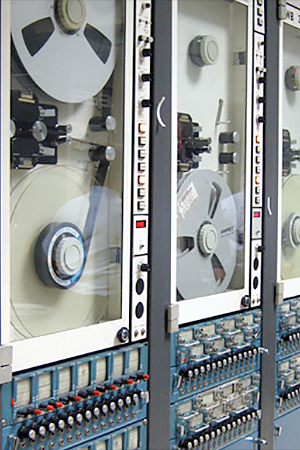November 3, 2006 — Vintage Apollo space missions tapes uncovered at a university in Western Australia are not what a team of experts are trying to locate.
"These aren't the tapes we're looking for," said John Sarkissian, operations scientist at the Commonwealth Scientific and Industrial Research Organization's (CSIRO) Parkes Radio Observatory in Parkes, Australia.
The story that is now making the rounds, Sarkissian added, refers to copies of one-inch magnetic tapes recorded at the Carnarvon station in Western Australia. They contain data from Apollo 11's Early Apollo Surface Experiments Package (EASEP) — a set of scientific instruments emplaced at the Apollo 11 landing site by the astronauts.
EASEP was the forerunner of what was called the ALSEP experiment packages, short for the Apollo Lunar Surface Experiment Package and used on the later Apollo missions.
Still at issue is the location of Apollo 11 Slow-Scan Television tapes (SSTV). [See story.] Those lost tapes could give the world a better view of the first human explorers as they walked upon the Moon more than three decades ago.
The SSTV recordings were of better quality than scan-converted imagery that — while fuzzy and far from crisp — enthralled a global audience of Apollo 11 moon watchers back here on Earth.
By recovering the SSTV, the hope is to provide the public a higher-quality, upgraded 21st century look at the exploits of Neil Armstrong and Buzz Aldrin — the lunar twosome that first set boot on the Moon back in July 1969.
A team of experts — both inside and outside of NASA — continue on their quest to pinpoint the Apollo TV tapes in question.
Regarding the on-going search for the Apollo SSTV tapes, Sarkissian added that "there's nothing new to report... unfortunately." The team in the United States is very deep into checking the various places the tapes may have been archived, he said.
"But we haven't yet found anything. There's been a lot of paper work uncovered, but not the tapes," Sarkissian reported.
Telemetry data
While news headlines talk about "lost Moon landing tapes" the actual tapes recently found were neither lost nor of the Moon landing, explained Bill Wood, a retired Apollo tracking station engineer in Barstow, California.
Wood is also part of the group that's on the hunt for the SSTV recordings, offering technical expertise gleaned from his background in supporting all of the Apollo missions at Goldstone — part of NASA's worldwide network of deep space antennas run by the Jet Propulsion Laboratory (JPL) in Pasadena, California.
Wood reiterated that what was found were data tapes from the Apollo 11 EASEP package left on the Moon by the Apollo 11 astronauts.
"NASA had the cooperation of many colleges and universities around the world to analyze data from the data packages left on the Moon," Wood advised. "Since NASA had a very close relationship with the Australian government in support of Apollo, the University of Sydney was supplied copies of EASEP and ALSEP telemetry data as part of the effort to learn more about the Moon."
Wood said that NASA still has detailed recordings of all the EASEP and ALSEP packages from activation until their respective nuclear power supplies were exhausted about 30 years later.
Running down leads
They have not found the tapes, Wood told SPACE.com. "But, we are running down every lead."
The inquiry into the whereabouts of the SSTV tapes has not proven easy.
Budget cuts at NASA in the post-Apollo years meant that many day-to-day records were discarded. Jobs and entire divisions that dealt with data records were eliminated.
Since there was no official requirement to archive data like this, Wood added, the SSTV tape could have gone the same way that many old television programs did: TV stations degaussed the tapes and reused them.
"But, no conclusions yet," Wood said. He noted that he spends most of his time calling one person after another to get tips about other people to contact. However, many of the individuals involved from long ago have passed away, making the task more difficult.
"It is taking contacts with retirees and others who were involved at the time to figure out what happened," Wood concluded. "So the search continues."
For details regarding the search for the Apollo 11 Slow- Scan Television Tapes, cast your eyes on these sites:
|
|

The machines pictured read the 1-inch-wide magnetic tape from their 14-inch round reels. Multiple machines are used because each reel only records about 15 minutes worth of data. As one reel films, the next machine automatically starts recording a slight overlap for data continuity. (NASA) |
